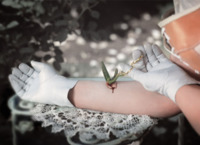Items
Site
The Medicine Chest
keywords is exactly
grafting
-

Resonance
"The revelation of my object-study that the chest was a lacuna in terms of local botanical medicinal remedies and practices served as inspiration for the first department I approached. By engaging with insiders of the Department of Biological Sciences, I reasoned that I could supplement the chest’s Western content with local botanical knowledge. As the first viewing session, it was also the one that initiated the weakening of the chest’s imperial viral load through an inoculation of additional meaning – a treatment with a surprising side-effect. On presenting the chest to other disciplinary insiders afterwards (to Pathology and the College of Music, for example), I noticed characteristics that also resonated with the field of botany within these disciplines and their collections. These botanical resonances accrued as my disciplinary engagements increased and diversified, leading me to embrace this side-effect and to use botany as the central theme of my exhibition. The resonances generated in the different departmental viewing sessions resulted in new links with the chest but also in connections surfacing between disciplines such as zoology, dermatology, pharmacology and sound studies, for example. I drew on these visits and their outcomes to create a range of artworks that materialised the inoculation of the chest by manifesting how intersecting with diverse fields expanded its meaning, and I sourced objects from the collections that encouraged new interpretations" (Liebenberg 2021: 244 - 246). -

Dis-Location/Re-Location
Farber's research examines themes of adaptation to new surroundings and circumstances through the real-life persona of Bertha Guttmann, a Jewish woman brought to South Africa from Sheffield in 1885 at the age of 22. She entered into an arranged marriage with Sammy Marks, who rose from being a peddler to one of the old Transvaal Republic’s leading industrialists. They lived in a beautiful home, now a museum, called Zwartkoppies, east of Pretoria. "Rather, from the initial cut, she inserts a seedling aloe into her flesh, delicately ‘planting’ the indigenous South African succulent into her forearm. This action represents a physical grafting of an alien botanical life form into the “lily-white corpus of Europe” (Ord 2008:106)" (Farber 2012: 35). Bertha Marks’s construction of the formal English rose garden on the ‘moral wastes’ of the Highveld could be recognised as part of a broader colonial project to ‘civilise’ the ‘barbaric’ African land. The road leading to the eastern gate of Zwartkoppies is lined with Eucalyptus trees planted by Sammy Marks. Rather as in his wife’s attempt to create her formal rose garden in her new surroundings and in so doing to ‘tame’ nature, Sammy Marks embarked on an ambitious campaign to “reclaim” and “green” Zwartkoppies, “creating a civilised landscape out of what his secretary called a wilderness” (Mendelsohn 1991:104). Thousands of trees were planted, mainly exotic varieties such as pines and blue gums, as well as orchards and vineyards (Mendelsohn 1991:104)" (Farber 2012: 58)


